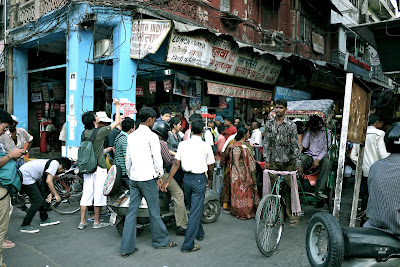A Reflection on Chandni Chowk and Shahjahanabad
Visited June 30, 2011
This essay is a reflection based on a visit to Old Delhi and Chandni Chowk in accordance to a report of the history on the particular place written earlier for INDA.
Chandni Chowk is still today, one of the busiest and most significant street market in Old Delhi. With the changes that occurred during the shift in political power in 1857 (British seizer) and 1947 (Indian Independence), the boulevard became more crowded and civic; used to be the surrounded by private haveli’s, the decline of the amir led to disintegration of the mansions, thus open up what used to be private-enclosed space to the merchants. The four-lane boulevard stretched from the old Red Fort to the Fatehpuri Masjid is now crowded with moving rickshaws, small cars typical to modern India (mostly Tata and Suzuki), coolie dragging pushcarts and wheel barrow, and pedestrian crossing and stopping along the rich and crowded community of the old city. On the sides of the boulevard shopfronts now fill the spaces between the religious monuments (Jain Temples, Masjids, and Hindu Temples) that was once the street barrier of the aristocrat’s residential haveli’s. Tourist stopped to shop for silverwares, electronics, indian snacks and dishes, fabrics, spices, minerals, jewelries, and etc. on the foot path connered with piles of trashes and animal feces. Either the sound of car honking, people shouting, Indian music, prayers, animals, or traffic movement is always negotiating in the air.
Inside the interconnecting alleyways along the boulevard the trace of once a single complex of haveli is hardly recognizable; facade of the, once continuous haveli boundary, is now divided into small cubicles of shops (with the space enough to fit just the merchant and two to three customers). These shops since bought out by the shop owners are now redesigned and renovated independently, the elements and facade extrusion of adjacent shops are varying along the narrow alleyway, undulating in and out as the owner wishes.
The result of the city originally planned for many big housing complex, after the transformation, gave the impression of typical asian dense community, almost a slum formation. The alleyways are mazed through the existing path between the original haveli’s and the interior of the disintegrated haveli’s to make ways into the interior of the complex that is now small residential units and shophouses. Modernization brought in the need for electricity and plumbing; evident by the unorganized bundle of electrical wire that jumps from one rooftop to the adjacent. Piping infrastructure became part of the unorganized systems, flowing along the floor, wall, and roof, of the urban fabric.

Map description of Chandni Chowk boulevard indicating zones and landmarks




No comments:
Post a Comment